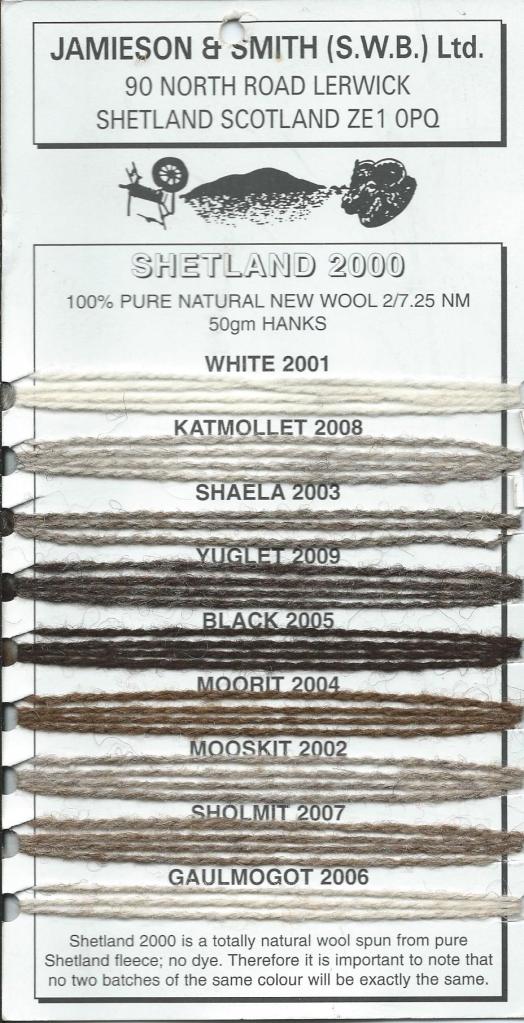There has been a great interest and debate over the descriptions of Shetland sheep and wool over quite a few decades, in particular the natural coloured. When I started out in wool in 1967, our yearly intake of wool contained vast amounts of native Shetland natural coloured fleece. Looking back into J & S archives roughly a quarter of the wool purchased was natural Shetland coloured, the island of Yell being the largest supplier of this wool that went through our hands. The topography of Yell with its heather clad hills and endless peat moors plus access to the sea shore made the island a perfect home for these very small hardy native Shetland sheep. In fact nearly all the coloured wool we bought was from Shetland hill bred sheep.


From a purely practical point of view in the wool store I was told, in order to keep wool classing simple and cost effective, the colours were grouped fairly simply. Shetland Black consisted of a dark chocolate brown and also a charcoal shade which would contain some white or light grey fibres. Moorit (brown) was made up of dark Moorit, Medium Moorit, and Light Moorit. Grey the same; dark, medium and light. It was far easier to identify the colour and markings of a Shetland sheep while it was attached to the animal then in a fleece that was often rolled up. It was only when I started judging wool with some of the older wool people such as the late P.B.Hunter that I became more aware of the individual names given to the various shades. Even then, depending on the district a particular individual came from, there would sometimes be a difference in the descriptive name for the coloured fleece.


In recent times in Shetland I have noticed a steep decline in local sheep breeders concentrating on breeding specific colours. This is due mainly to a distinct lack of marketing in the smaller finished Shetland lamb and in particular the coloured lamb. I have asked many times why this should especially apply to the coloured lamb, the answer normally is that the buyers are not keen on them but I never get a reason why that is.

As mentioned in a previous blog prior to 1997 there was no demand for Shetland coloured wool and the returns to the producers was pence. Wool mills spinning Shetland wool preferred to dye up white wool simulating a natural shade and still be able to call it natural. With the introduction in 1997 of Shetland 2000 which was an international collaboration between Yarns International, Bethesda, Maryland, and Jamieson & Smith Shetland Wool Brokers a much needed positive change took place in this unique natural wool. The aim of the venture was to produce a truly natural undyed yarn from the native Shetland hill sheep which offered the user a truly unique experience. Its natural softness makes it pleasant to work with and equally comfortable to wear, while the natural saturation of the colours gives the knitted piece richness and a depth unavailable in dyed yarns. Moreover, the absence of any dye or chemical processing yields an environmentally friendly product. After the launch of these yarns there was a marked improvement in the demand and price for the finer grades of natural Shetland coloured wool. It was also interesting to note that other users and organisations started to offer natural Shetland coloured wools. This all has helped to improve the lot of the native Shetland coloured sheep from a wool point perspective.


As I mentioned in a previous blog I was most fortunate to meet and become friends with the late Stanley Bowie who always championed the cause of native Shetland animals especially the native sheep. Stanley would visit our store in the wool season and would spend hours down in the basement amongst the finest of our coloured wool testing and photographing all the various shades and markings on a fleece. Stanley provided me with a lot of information on the various colours and markings. I am correct there were thirty descriptive names. Much of his information came from the writings of Norse historian, Jakobsen who said there were indeed many more words in the ancient Norn language pertaining to specific colours which sadly have been lost.


Today we are most fortunate that the Shetland Sheep society on the U.K. mainland since the 1970s fought to safeguard these names through selective breeding of Shetland sheep. I must admit to having a limited knowledge of these individual descriptions of coloured sheep, I prefer to leave that to the experts; the breeders of the sheep. I will list below the five main whole colours in Shetland sheep passed on to me by my friend the late Stanley Bowie.


Shetland dialect / English equivalent
Shaela – Dark steely – grey. Emsket – Dusky bluish-grey. Musket – Pale greyish-brown. Mioget –Light moorit ( yellowish-brown). Moorit –Light to dark reddish-brown.
